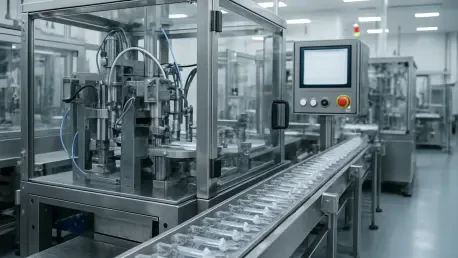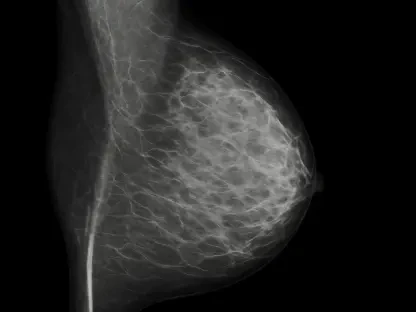The medical device manufacturing sector is undergoing a profound shift as automation emerges as a cornerstone of modern production, promising to redefine the way critical healthcare tools are created and delivered to market. With global demand for sophisticated medical devices soaring, manufacturers face unprecedented challenges in achieving precision, scaling operations, and adhering to rigorous regulatory standards. Technologies such as robotics, artificial intelligence (AI), and the Industrial Internet of Things (IIoT) are stepping in as vital solutions, offering ways to enhance efficiency and tackle complexities that manual processes can no longer handle. Beyond merely streamlining workflows, automation is becoming an essential strategy for staying competitive in a rapidly evolving industry. With market projections indicating that automation in this field will surpass $9 billion this year and continue to expand through 2035, the impact of these advancements cannot be overstated. This exploration delves into the transformative power of automation, highlighting its role in reshaping manufacturing practices and ensuring the future of medical technology remains innovative and accessible.
Driving Precision and Cost Efficiency
The increasing intricacy of medical devices, from tiny wearable health monitors to complex surgical instruments, presents a significant challenge for manufacturers striving to maintain consistent quality. Automation technologies, particularly robotics and AI, are proving indispensable in meeting these demands by executing tasks like assembly and inspection with unparalleled accuracy. This precision drastically reduces defects and ensures that even the smallest components are crafted to exact specifications. As a result, manufacturers can deliver reliable products that meet the high standards expected in healthcare, where patient safety is paramount. The shift to automated systems also eliminates much of the variability inherent in human labor, creating a more dependable production line that can handle the delicate nature of modern medical tools without sacrificing speed or quality.
Beyond precision, automation offers a compelling solution to the pressing need for cost-effective production in an industry under constant pressure to scale. As global demand for medical devices escalates, companies must increase output without inflating expenses or compromising on standards. Automated systems excel in this area by minimizing material waste, cutting down on human error, and optimizing workflows to boost overall efficiency. This allows manufacturers to produce larger volumes at a reduced cost per unit, making life-saving technologies more affordable and accessible to a broader population. Furthermore, the reduction in operational inefficiencies translates to faster time-to-market, enabling companies to respond swiftly to emerging healthcare needs. Automation, therefore, not only addresses financial constraints but also positions manufacturers to remain agile in a competitive landscape where cost and speed are critical factors.
Meeting Regulatory Demands with Advanced Tools
Navigating the stringent regulatory landscape of medical device manufacturing is a daunting task, with strict guidelines in place to ensure patient safety and product reliability across global markets. Automation is becoming a key ally in this arena by providing consistent, repeatable processes that align with compliance requirements. Technologies integrated with IIoT and cloud systems enable real-time monitoring and data collection, ensuring that every step of production is documented and traceable. This transparency simplifies audits and helps manufacturers demonstrate adherence to standards set by governing bodies. By reducing the risk of non-compliance penalties, automated systems offer a pathway to maintain trust with regulators and end-users alike, while also safeguarding the integrity of the devices produced.
Another significant advantage of automation lies in its capacity to foster a data-driven manufacturing environment that enhances regulatory alignment. Predictive maintenance, powered by smart sensors and advanced analytics, allows companies to address equipment issues before they disrupt production, minimizing downtime and ensuring continuous operation. This proactive approach not only supports compliance by maintaining steady output but also provides detailed insights into production processes, enabling ongoing improvements. Additionally, the ability to track performance metrics in real time helps identify potential quality issues early, preventing costly recalls or delays. As regulatory scrutiny intensifies worldwide, the adoption of such technologies ensures that manufacturers can uphold the highest standards without sacrificing efficiency, positioning them to thrive in a tightly controlled industry where precision and accountability are non-negotiable.
Building Resilience Against Supply Chain Challenges
Global supply chain disruptions, particularly those exacerbated by U.S. trade tariffs on essential components like sensors and precision electronics, have posed significant obstacles for medical device manufacturers. These tariffs have driven up costs and caused delays in automation projects, impacting the timely deployment of critical technologies. However, this challenge has prompted a strategic rethink among industry players, pushing them to diversify supplier networks and explore alternative sourcing options. Automation plays a central role in this adaptation by enabling more localized production through nearshoring and reshoring initiatives. By reducing dependency on volatile international supply chains, automated systems help manufacturers mitigate risks and maintain stability in the face of geopolitical and economic uncertainties.
The shift toward supply chain resilience also highlights how automation can enhance operational independence and flexibility. By integrating advanced technologies, companies can streamline production closer to key markets, cutting down on lead times and transportation costs. This approach not only counters the financial strain imposed by tariffs but also strengthens the ability to respond to sudden shifts in demand or regulatory changes. Furthermore, automation facilitates the creation of modular manufacturing setups that can be scaled or adjusted as needed, providing a buffer against future disruptions. As manufacturers recalibrate their strategies to prioritize stability, the role of automated systems in building robust, adaptable supply chains becomes increasingly evident, ensuring that production remains uninterrupted even in challenging global conditions.
Shaping the Future with Smart Manufacturing
The advent of smart factories, underpinned by Industry 4.0 principles, marks a pivotal evolution in medical device manufacturing, with automation at its core. Innovations such as digital twins—virtual replicas of physical production systems—and AI-driven quality control are now integral to maintaining a competitive edge. These tools allow for real-time simulation and monitoring, enabling manufacturers to identify inefficiencies or potential failures before they occur. The result is a more agile production environment where issues can be addressed proactively, ensuring high-quality output and reducing costly downtime. As these technologies become standard, they redefine operational excellence, making automation not just a tool for efficiency but a foundation for sustained innovation in the sector.
Equally transformative is the emphasis on flexibility and scalability that automation brings to smart manufacturing. Reprogrammable platforms and adaptive systems enable manufacturers to handle diverse product portfolios and accommodate shorter innovation cycles with ease. This adaptability is crucial in an industry where rapid advancements and personalized medical solutions are becoming the norm. By facilitating quicker product changeovers and customized production runs, automation ensures that companies can meet evolving market demands without overhauling entire systems. Looking ahead, the integration of these smart technologies will continue to drive growth, particularly in emerging markets where healthcare infrastructure is expanding rapidly. Automation stands as the backbone of this progress, equipping manufacturers to navigate complexity and seize new opportunities in a dynamic global landscape.
Reflecting on Automation’s Lasting Impact
Looking back, the journey of automation in medical device manufacturing reveals a remarkable transformation, as it evolved from a supplementary tool to an indispensable pillar of the industry. It has tackled pressing challenges like precision in complex designs, cost pressures, and stringent regulatory demands with unparalleled effectiveness. The adoption of robotics, AI, and IIoT systems has redefined production standards, ensuring that quality and efficiency go hand in hand. Even external hurdles, such as supply chain disruptions driven by trade tariffs, were met with strategic shifts that automation made possible, fostering resilience through diversified and localized operations. As the industry adapted, smart manufacturing principles took root, embedding flexibility and innovation into the core of production processes. Moving forward, manufacturers should prioritize investments in scalable automated solutions and explore partnerships to integrate cutting-edge technologies. Embracing these advancements will be key to sustaining growth and addressing future healthcare demands with confidence.









